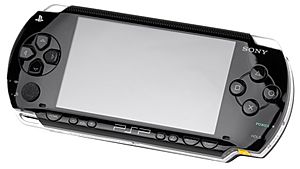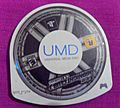PlayStation Portable facts for kids
 |
|

Original model (PSP-1000) and logo of the PSP.
|
|
| Manufacturer | Sony Computer Entertainment |
|---|---|
| Type | Handheld game console |
| Generation | Seventh generation |
| Retail availability |
|
| Discontinued |
|
| Units sold | Worldwide: 76.3 million (as of March 31, 2012[update]) (details) |
| Media | UMD, digital distribution |
| CPU | 333 MHz MIPS R4000 |
| Memory | 32 MB (PSP-1000); 64 MB (2000, 3000, Go, E1000) |
| Storage | Memory Stick Duo, Memory Stick PRO Duo (from 32 MB to 32 GB), Memory Stick Micro (for PSP Go) |
| Display | 480 × 272 pixels with 16,777,216 colors, 16:9 widescreen TFT LCD, 3.8 in (97 mm) (PSP GO), 4.3 in (110 mm) (All other models) |
| Connectivity | Wi-Fi (802.11b), IrDA (PSP-1000), USB, Bluetooth (PSP Go) |
| Online services | PlayStation Network |
| Dimensions | PSP1000: 74 mm (2.9 in) (h) 170 mm (6.7 in) (w) 23 mm (0.91 in) (d) PSP2000/3000: 71 mm (2.8 in) (h) 169 mm (6.7 in) (w) 19 mm (0.75 in) (d) PSP GO: 69 mm (2.7 in) (h) 128 mm (5.0 in) (w) 16.5 mm (0.65 in) (d) |
| Weight | PSP1000: 280 grams (9.9 oz) PSP2000/3000: 189 grams (6.7 oz) PSP GO: 158 grams (5.6 oz) |
| Best-selling game | Monster Hunter Portable 3rd (4.6 million) (as of May 6, 2011) |
| Predecessor | PocketStation |
| Successor | PlayStation Vita |
The PlayStation Portable, or PSP, was a cool handheld game console made by Sony. It was the first portable game system from Sony. It first came out in Japan on December 12, 2004. Later, it arrived in North America on March 24, 2005, and in Europe on September 1, 2005.
Sony first talked about the PSP in 2003 at a big event called E3. The next year, they showed off its first design. The PSP could play video games, music, videos, and show pictures. You could transfer files like music or videos from a computer using a USB cable.
Games and movies for the PSP came on a special disc called a "Universal Media Disc" (UMD). These discs could hold 1.8 GB of data. This was a lot more than a regular CD but less than a DVD. The PSP was the first handheld game console to use discs instead of game cartridges. You could also use a Memory Stick Pro Duo for extra storage.
Sony stopped shipping the PlayStation Portable in North America in January 2014. Shipments also ended in Japan in June 2014 and in Europe by the end of 2014.
Contents
Games and Movies on PSP
There were over 700 games available for the PSP. You could also watch movies on it, which looked similar to DVDs. The UMD disc had enough space to store full movies. In many countries, the movie Spider-Man 2 was given away for free with the console.
Wireless Features
The PSP had wireless features, meaning it could connect to the internet and other PSPs without cables. This was called Wi-Fi. This feature allowed players to download new content, browse the web, and play games online with friends. The PlayStation Portable could also connect with the PlayStation 3 console. It could act like a remote control for playing movies or downloading things.
Different PSP Models
There were five main versions of the PlayStation Portable:
- PSP-1000: This was the original model, sometimes called the "PSP fat" because it was thicker.
- PSP-2000: This version was known as the "slim and light" edition. It was thinner and lighter than the first PSP.
- PSP-3000: Called the "bright and light" edition, this model had a built-in microphone and a better LCD screen.
- PSP-N1000 (or PSP Go): This model had a unique sliding screen design. It also included Bluetooth and 16GB of built-in storage. It did not use UMD discs.
- PSP-E1000: This version was similar to the PSP-3000 but did not have stereo sound, Wi-Fi, or a microphone.
Sony later released the PlayStation Vita on February 22, 2012. This was the next portable console after the PSP.
PSP's Competition
The PlayStation Portable was similar to the Nintendo DS. Both were handheld systems for playing games on the go. However, Sony and Nintendo said their consoles were made for different types of players. The Nintendo DS sold more units than the PSP.
Images for kids
-
Memory Stick PRO Duo Slot on a Crisis Core: Final Fantasy VII edition PSP Slim
-
PSP running a "Hello, World!" program
-
A typical PSP game, on a Universal Media Disc
See also
 In Spanish: PlayStation Portable para niños
In Spanish: PlayStation Portable para niños











